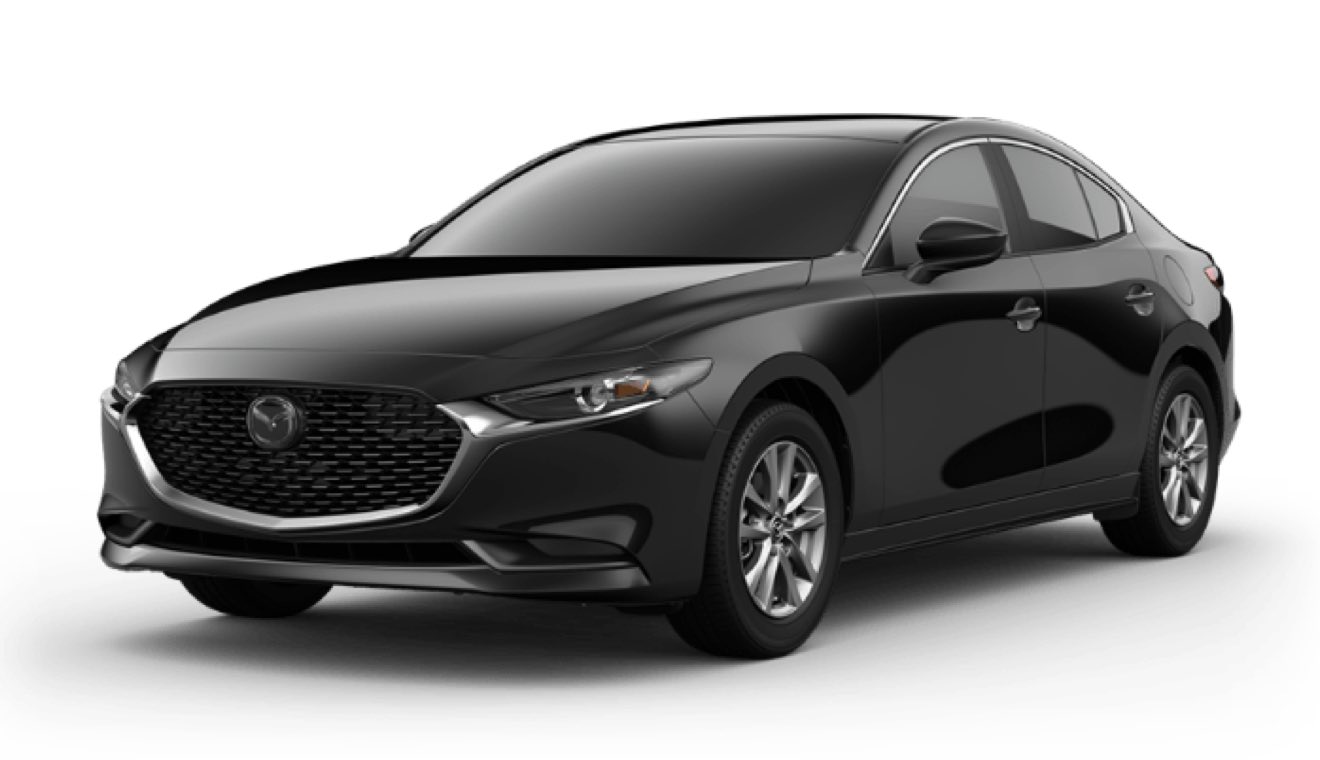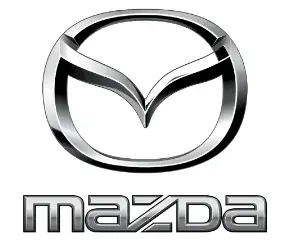2021 Mazda3 Seats and Seat Belt User Manual
Introduction
The Mazda3 is a beautiful and adaptable compact car that, in addition to a solid driving experience, offers a pleasant and well-designed seating configuration. Let’s examine the Mazda3’s 2021 seats and seatbelts in more detail. The Mazda3 has well-designed seats that offer support and comfort. With plenty of padding and bolstering, the front seats are made to keep the driver and passenger comfortable throughout lengthy rides. You can find the ideal driving posture thanks to the seats’ numerous adjustments, which include height adjustment, lumbar support, and power adjustments in higher trim levels. The Mazda3 has a spacious interior that can hold up to five passengers. Even taller passengers may sit comfortably in the front and back seats because to their generous leg and headroom. You can expand the cargo space as needed thanks to the 60/40 split-folding mechanism on the back seats.
Seat belts: Because safety is Mazda’s top priority, the 2021 Mazda3 comes with cutting-edge seat belt systems to safeguard passengers in the case of an accident. All seats in the vehicle, including the middle one in back, have three-point seat belts. Three-point seat belts offer greater safety than typical lap belts because they are made to secure the occupant’s lap and shoulder locations.
Seats and Seat Belt
Seat Precautions
Make sure the adjustable components of a seat are locked in place:
Adjustable seats and seatbacks that are not securely locked are dangerous. In a sudden stop or collision, the seat or seatback could move, causing injury. Make sure the adjustable components of the seat are locked in place by attempting to slide the seat forward and backward and rocking the seatback.
Never allow children to adjust a seat:
Allowing children to adjust a seat is dangerous as it could result in serious injury if a child’s hands or feet become caught in the seat.
Do not drive with the seatback unlocked:
All of the seatbacks play an important role in your protection in a vehicle. Leaving the seatback unlocked is dangerous as it can allow passengers to be ejected or thrown around and baggage to strike occupants in a sudden stop or collision, resulting in severe injury. After adjusting the seatback at any time, even when there are no other passengers, rock the seatback to make sure it is locked in place.
Adjust a seat only when the vehicle is stopped:
If the seat is adjusted while the vehicle is being driven, the seating posture may become unstable and the seat could move unexpectedly resulting in injury.
Do not modify or replace the front seats:
Modifying or replacing the front seats such as replacing the upholstery or loosening any bolts is dangerous. The front seats contain air bag components essential to the supplemental restraint system. Such modifications could damage the supplemental restraint system and result in serious injury. Consult an Authorized Mazda Dealer if there is any need to remove or reinstall the front seats.
Do not drive with damaged front seats:
Driving with damaged front seats, such as seat cushions torn or damaged down to the urethane, is dangerous. A collision, even one not strong enough to deploy the air bags, could damage the front seats which contain essential air bag components. If there was a subsequent collision, an air bag may not deploy which could lead to injuries. Always have an Authorized Mazda Dealer inspect the front seats, front seat belt pretensioners and air bags after a collision.
Do not drive with either front seats reclined:
Sitting in a reclined position while the vehicle is moving is dangerous because you do not get the full protection from seat belts. During sudden braking or a collision, you can slide under the lap belt and suffer serious internal injuries. For maximum protection, sit well back and upright.
Do not place an object such as a cushion between the seatback and your back:
Putting an object such as a cushion between the seatback and your back is dangerous because you will be unable to maintain a safe driving posture and the seat belt cannot function at its full capacity in a collision, which could result in a serious accident, injury or death.
Do not place objects under the seat:
The object could get stuck and cause the seat to not be fixed securely, and result in an accident.
Do not stack cargo higher than the seatbacks:
Stacking luggage or other cargo higher than the seatbacks is dangerous. During sudden braking or a collision, objects can fly around and become projectiles that may hit and injure passengers.
Make sure luggage and cargo is secured before driving:
Not securing cargo while driving is dangerous as it could move or be crushed during sudden braking or a collision and cause injury. Additionally, if the air bags deploy, the cargo may scatter which could result in serious injury or death.
Never allow a passenger to sit or stand on the folded seatback while the vehicle is moving:
Driving with a passenger on the folded seatback is dangerous. Allowing a child to sit up on the folded seatback while the vehicle is moving is particularly dangerous. In a sudden stop or even a minor collision, a child not in a proper seat or child-restraint system and seat belt could be thrown forward, back or even out of the vehicle resulting in serious injuries or death. The child in the baggage area could be thrown into other occupants and cause serious injury.
Never give the car keys to children and do not allow them to play in the vehicle
(4–Door):
Playing with the folding rear seats is dangerous. Once the seatbacks are back up, a child in the trunk would not be able to get out the way they had entered. If you have small children, keep the seatbacks locked.
Always leave your car locked and keep the car keys safely away from children
(4–Door):
Leaving your car unlocked or the keys in reach of children is dangerous. Children who find their way into the trunk through an unlocked rear seatback or an open trunk can become accidentally locked in the trunk. This could result in death or brain damage from heat prostration, particularly in the summer. Always lock the doors and the trunk, and as an added measure, keep the rear seatbacks locked, whether you have children in your home or not.
When operating a seat, be careful not to put your hands or fingers near the moving parts of the seat or on the side trim to prevent injury. When moving the seats, make sure there is no cargo in the surrounding area. If the cargo gets caught it could damage the cargo.
(Manual Seat)
When moving the seats forward and rearward or returning a rear-reclined seatback to its upright position, make sure you hold onto the seatback with your hand while operating. If the seatback is not held, the seat will move suddenly and could cause injury. When inserting your hand under the seat to clean the cabin or pick up something you dropped under the seat, be careful not to hurt yourself. If you contact the moving parts and surrounding parts around the seat rail, seat frame, and the bottom of the seat, it could result in injury.
When returning a rear seat to its original position, place the seat belt in its normal position. Verify that the seat belt pulls out and retracts.
(Power Seat)
The seat-base power adjustment is operated by motors. Avoid extended operation because excessive use can damage the motors.
To prevent the battery from running down, avoid using the power adjustment when the engine is stopped. The adjuster uses a large amount of electrical power.
Do not use the switch to make more than one adjustment at a time.
Front Seat
Adjusting the Driver’s Seat
Using the driving position set up procedure recommended by Mazda allows you to maintain a relaxed posture, drive the vehicle for longer periods without feeling tired, and make quick operations naturally.
Also, you can be assured of a clear view in the forward direction to help you drive more safely and comfortably.
The adjustments for the driving position recommended by Mazda are done using the following procedures.
- Moving the steering wheel and seat to their default positions.
- Adjusting the seatback angle.
- Adjusting the seat position forward and back.
- Adjusting the seat height.
- Adjusting the height on the front edge of the seat bottom.
- Adjusting the steering wheel position.
- Adjusting the head restraint position.
Manual seat
- Seat Slide
To move a seat forward or backward, raise the lever and slide the seat to the desired position and release the lever. Make sure the lever returns to its original position and the seat is locked in place by attempting to push it forward and backward. - Height Adjustment
To adjust the seat height, move the lever up or down. - Height Adjustment for Front Edge of Seat Bottom
- To adjust the height for front edge of the seat bottom, rotate the dial to the desired position.
- Seat Recline
- To change the seatback angle, lean forward slightly while raising the lever. Then lean back to the desired position and release the lever. Make sure the lever returns to its original position and the seatback is locked in place by attempting to push it forward and backward.
Power seat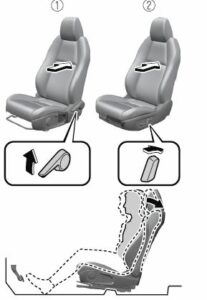
- Seat Slide
To slide the seat, move the slide lifter switch on the outside of the seat to the front or back and hold it. Release the switch at the desired position. - Height Adjustment
To adjust the seat height, move the slide lifter switch up or down. - Height Adjustment for Front Edge of Seat Bottom
To adjust the front height of the seat bottom, raise or lower the front of the slide lifter switch. - Seat Recline
To change the seatback angle, press the front or rear side of the reclining switch. Release the switch at the desired position. - Lumbar Support Adjustment
To increase the seat firmness, press and hold the front part of the switch to the desired position, then release it.
Press the rear part of the switch to decrease firmness.
Before making adjustments to the driving position recommended by Mazda
Before making adjustments, move the steering wheel and seat to their default positions.
How to move the steering wheel to its default position
Never adjust the steering wheel while the vehicle is moving:
Adjusting the steering wheel while the vehicle is moving is dangerous. Moving it can very easily cause the driver to abruptly turn to the left or right. This can lead to loss of control or an accident.
After adjusting the steering wheel position, make sure it is securely locked by trying to move it up and down:
Driving with the steering wheel not securely locked in position is dangerous. If the steering wheel moves unexpectedly while driving, you could lose control of the steering resulting in an accident. Lower the lever, move the steering wheel to the lowest position, and then push it down and all the way back.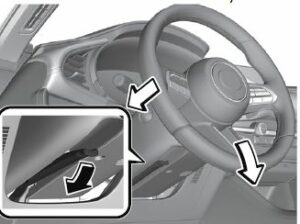
How to move a driver’s seat to its default position
- Slide the seat all the way back.
- Lower the seat to its lowest height.
- Lower the front edge of the seat bottom to its lowest height.
- Sit squarely in the seat and rest your back against the seatback.
Seat adjustment procedure for the driving position recommended by Mazda
Adjusting the seatback angle (reclining)
Adjust the seatback to the angle providing a comfortable seated posture.
- With your posture slightly slouched, move the seatback forward to the angle where your waist feels slightly cramped.

- Manual Seat
- Power Seat
- Move the seatback backward to a comfortable seated posture without any feeling of cramping in your waist.
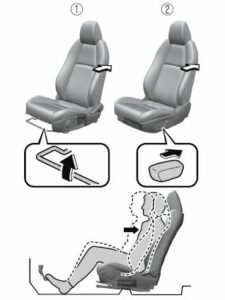
- Manual Seat
- Power Seat
Adjusting the seat position forward and back (sliding)
Adjust the seat to the position best for operating the accelerator and brake pedals.
- Place your left foot on the footrest, your right foot between the accelerator and brake pedals, and position your heel to the position allowing easy switching between the pedals.
- With your heel set on the floor, set your right foot on the brake pedal and move the seat forward as far as possible until you feel a slight cramping in your ankle.
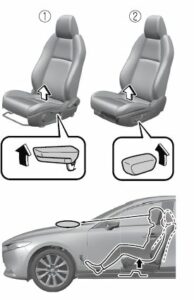
- Manual Seat
- Power Seat
- With your right foot set on the brake pedal, move the seat back until you no longer feel cramping in your ankle.
- With your heel set on the floor, make sure you can move your foot between the brake pedal and accelerator pedal smoothly.
- Depress the accelerator pedal completely with your heel set on the floor and make sure that your ankle does not feel over-stretched.
- Manual Seat
- Power Seat
Adjusting the seat height
- Adjust the seat height to a position where you have a clear forward view and you can drive the vehicle easily.
- With your back resting against the seatback, raise the seat to the height where you can see the rear edge area of the hood surface from the windshield.
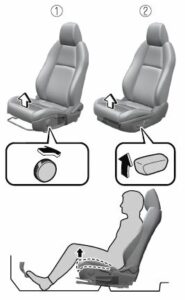
- Manual Seat
- Power Seat
Adjusting the height on the front edge of the seat bottom
- Adjust the height on the front edge of the seat bottom to the position where the back of your knees contacts the front edge of the seat bottom.
- With your right foot set on the accelerator pedal, adjust the height on the front edge of the seat bottom so that the back of your knees lightly contacts the front edge of the seat bottom.
- Depress the accelerator pedal and make sure that you no longer feel cramping in the back of your knees.

- Manual Seat
- Power Seat
Adjusting the steering wheel position
- Adjust the steering wheel to the position where it can be operated easily and the gauges can be viewed easily.
- With your back resting against the seatback, extend both arms, place them on the top of the steering wheel, and pull the steering wheel towards you to the position of your wrists.
- Adjust the steering wheel height so that the gauges can be viewed easily.
- Raise the lever to securely lock the steering wheel.

Adjusting the head restraint position
To prevent shock to the head and neck, adjust the head restraints to their correct positions Refer to Height Adjustment (Search).
Driving Position Memory (Power Seat) (Some Models)
- The desired driving position can be called up after programming the position.
- The following driving positions can be programmed.
- Driver’s seat position (seat slide, height adjustment, front edge of seat bottom, seat recline)
- Refer to Adjusting the Driver’s Seat (Search).
- Active driving display (display position, brightness level, display information)
- Refer to Active Driving Display (Search).
- Outside mirror angle
- Refer to Outside Mirrors (Search).
- A driving position can be programmed to the following parts.
- Position memory button
- Transmitter used for vehicle
NOTE - Lumbar support adjustment cannot be programmed.
Programming
- Make sure the parking brake is on.
- (Automatic transmission)
- Make sure the selector lever is in the P position.
- Switch the ignition ON.
- Adjust the following parts to the desired conditions.
- Driver’s seat
- Active driving display
- Outside mirrors
- Press the SET button continuously until a sound is activated.
- 1 button
- 2 button
- SET button

Do the following operation within 5 seconds after the sound is activated to program the driving position.
- Programming to a position memory button
Press the button you want to program, either 1 or 2 button. - Programming to the transmitter
Press the unlock button on the transmitter.
A sound is activated when the operation is completed correctly.
NOTE
- If you do not perform the operation correctly, a sound indicating that the programming has failed is activated.
- If the angle of the outer mirrors only changes a little, the angle of the outer mirrors may not have been programmed correctly.
- If the angle of the outer mirrors is adjusted close to the limits of its range of motion, the driving position can be successfully programmed, but it may fail when calling up the programmed driving position.
Calling up the programmed driving position
CAUTION
Do not place fingers or hands around the bottom of the seat while the seat memory function is operating. The seat moves automatically while the seat memory function is operating and fingers or hands could get pinched and injured.
Using the position memory button
Make sure the parking brake is on.
(Automatic transmission)
Make sure the selector lever is in the P position.
Switch the ignition ON.
Press the programming button for the driving position you want to call up (button 1 or 2).
A sound is activated when the adjustment to the programmed driving position is completed.
NOTE
- When adjustment of the driving position is not necessary, a sound is not activated.
- The driving position adjustment is canceled in the following cases:
- The seat adjustment switch on the driver’s seat is operated.
- The angle of the outer mirrors is adjusted.
- The SET button is pressed.
- Programming button 1 or 2 is pressed.
- The lock button or unlock button on the transmitter is pressed.
- The vehicle starts moving.
- The active driving display is adjusted.
- (Manual transmission)
- The parking brake is released.
- (Automatic transmission)
- The selector lever is shifted to a position other than P.
Using the transmitter
- Unlock the driver’s door using one of the following methods.
- Touch the sensing area of the door release touch sensor.
- Press the unlock button on the transmitter.
- When you open the driver’s door within 90 seconds after unlocking the doors, the adjustment of the following parts starts.
- Driver’s seat
- Active driving display (When the ignition is switched ON, the adjusted active driving display is activated.)
- Outside mirrors
A sound is activated when the adjustment is completed.
NOTE
- When adjustment of the driving position is not necessary, a sound is not activated.
- The driving position adjustment is canceled in the following cases:
- The seat adjustment switch on the driver’s seat is operated.
- The angle of the outer mirrors is adjusted.
- The SET button is pressed.
- Programming button 1 or 2 is pressed.
- The lock button or unlock button on the transmitter is pressed.
- The vehicle starts moving.
- The active driving display is adjusted.
- (Manual transmission)
- The parking brake is released.
- (Automatic transmission)
- The selector lever is shifted to a position other than P.
Erasing programmed driving positions
Erasing the driving positions programmed to the key
Switch the ignition OFF.
- Press the SET button continuously until a sound is activated.
- Press the lock button on the transmitter within 5 seconds after the sound is activated.
- If you do not perform the operation correctly, a sound indicating that the programming has failed is activated.
Adjusting the Front Passenger’s Seat
- Seat Slide
To move a seat forward or backward, raise the lever and slide the seat to the desired position and release the lever.
Make sure the lever returns to its original position and the seat is locked in place by attempting to push it forward and backward. - Seat Recline
To change the seatback angle, lean forward slightly while raising the lever. Then lean back to the desired position and release the lever.
Make sure the lever returns to its original position and the seatback is locked in place by attempting to push it forward and backward.
Rear Seat
Split Folding the Seatbacks
By lowering the rear seatbacks the luggage compartment space can be expanded.
WARNING
Do not drive the vehicle with occupants on folded down seatbacks or in the luggage compartment.
Putting occupants in the luggage compartment is dangerous because seat belts cannot be fastened which could lead to serious injury or death during sudden braking or a collision.
Do not allow children to play inside the vehicle with the seatbacks lowered.
Allowing children to play in the vehicle with the seatbacks folded down is dangerous. If a child enters the luggage compartment and the seatbacks were raised back up, the child may become trapped in the luggage compartment which could lead to an accident.
Tightly secure cargo in the luggage compartment when it is transported with the seatbacks folded down.
Driving without tightly securing cargo and luggage is dangerous as it could move and become an obstruction to driving during emergency braking or a collision resulting in an unexpected accident.
When transporting cargo, do not allow the cargo to exceed the height of the seatbacks
Transporting cargo stacked higher than the seatbacks is dangerous as visibility to the rear and sides of the vehicle is reduced which could interfere with driving operations and lead to an accident.
Lowering the seatbacks
(5–Door)
When folding the seatback forward, always support the seatback with your hand. If it is not supported by a hand, fingers or the hand pressing the push knob could be injured.
Check the position of a front seat before folding a rear seatback.
Depending on the position of a front seat, it may not be possible to fold a rear seatback all the way down because it may hit the seatback of the front seat which could scratch or damage the front seat or its pocket. Lower or remove the head restraint on the rear outboard seat if necessary.
(4–Door)
- Open the trunk lid and pull the lever of the seatback you want to fold down.
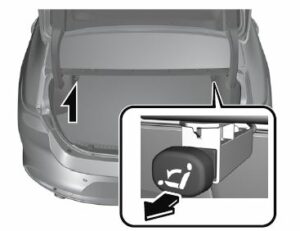
- Open a rear door and fold the rear seat forward.
(5–Door)
Press the push knob to fold down the seatback.
To return the seatback to its upright position:
When returning a seatback to its upright position, make sure the 3-point seat belt is not caught in the seatback and the 3-point seat belt is not twisted.
If the seat belt is used while it is twisted and caught in the seatback, the seat belt cannot function at its full capacity, which could cause serious injury or death.
When returning a seatback to its upright position, make sure that it is firmly locked and the red indication is not visible (5–Door).
If the red indication is visible behind the push knob, it means the seatback is not locked. If the vehicle is driven without the seatback locked, it could fold down suddenly and cause an accident.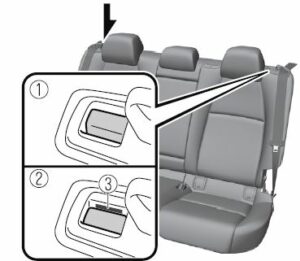
- Locked position
- Unlocked position
- Red indication

Make sure that the seat belt passes through the seat belt guide correctly and it is not twisted, then raise the seatback while preventing the seat belt from being caught in the seatback.
(4–Door)
Seat belt guides
(5–Door)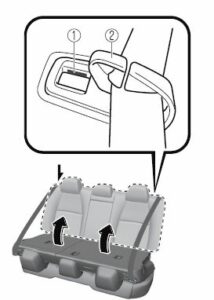
-
- Red indication
- Seat belt guide
- Press the seatback rearward and lock it in place. After returning the seatback to its upright position, make sure it is securely locked.
Armrest
The rear armrest in the center of the rear seatback can be used (no occupant in the center seat) or placed upright.
WARNING
Never put your hands and fingers around the moving parts of the seat and armrest:
Putting your hands and fingers around the moving parts of the seat and armrest is dangerous as they could get injured.
Head Restraints
Your vehicle is equipped with head restraints on all outboard seats and the rear center seat. The head restraints are intended to help protect you and the passengers from neck injury.
WARNING
Always drive with the head restraints installed when seats are being used and make sure they are properly adjusted:
Driving with the head restraints adjusted too low or removed is dangerous. With no support behind your head, your neck could be seriously injured in a collision.
Height Adjustment
Adjust the head restraint so that the center is even with the top of the passenger’s ears.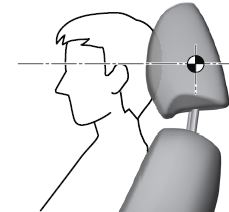
To raise a head restraint, pull it up to the desired position. To lower the head restraint, press the stop-catch release, then push the head restraint down.
Front seats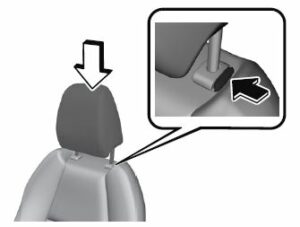
Rear outboard seats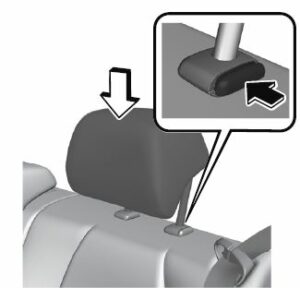
Rear center seat
Removal/Installation
To remove the head restraint, pull it up while pressing the stop-catch. To install the head restraint, insert the legs into the holes while pressing the stop-catch.
WARNING
Always drive with the head restraints installed when seats are being used and make sure they are properly installed:
Driving with the head restraints not installed is dangerous. With no support behind your head, your neck could be seriously injured in a collision.
After installing a head restraint, try lifting it to make sure that it does not pull out:
Driving with an unsecured head restraint is dangerous as the effectiveness of the head restraint will be compromised which could cause it to unexpectedly detach from the seat.
CAUTION
- When installing a head restraint, make sure that it is installed correctly with the front of the head restraint facing forward. If the head restraint is installed incorrectly, it could detach from the seat during a collision and result in injury.
- The head restraints on each of the front and rear seats are specialized to each seat. Do not switch around the head restraint positions. If a head restraint is not installed to its correct seat position, the effectiveness of the head restraint during a collision will be compromised which could cause injury.
Seat Warmer
The front seats can be warmed up while the engine is running.
The front seats can be warmed up while the engine is running.
While the seat warmer is operating, the indicator light in the seat warmer switch turns on according to the set temperature.
Manual mode
When the seat warmer switch is pressed, the seat warmer operates in manual mode.
The set temperature changes as shown in the figure each time the seat warmer switch is pressed.
- OFF
- High
- Mid
- Low
NOTE
If the engine is turned off while the seat warmer is operating in manual mode, the seat warmer does not turn on automatically the next time the engine is turned on. To turn the seat warmer on, press the switch again.
Auto mode
The driver and front passenger’s seat warmer can be operated in auto mode using the following procedure.
- If “Occupant Comfort” has been disabled, enable it using the following procedure.
- Select “Settings” from the Mazda Connect home screen.
- Select “Vehicle Settings”.
- Enable “Occupant Comfort”.
- Press the AUTO switch.
While in auto mode, the seat temperature is automatically controlled in 4 levels (High, Mid, Low, and OFF) according to the conditions in the cabin.
NOTE
- If the front passenger’s seat belt is unfastened, the front passenger’s seat warmer turns off.
If the seat warmer switch is pressed during auto mode, the seat warmer on the side where the switch was pressed switches to manual mode. To return to auto mode, press the AUTO switch.
If the engine is turned off while the seat warmer is operating in auto mode, the seat warmer operates in auto mode again the next time the engine is turned on.
WARNING
Be careful when using the seat warmer:
The heat from the seat warmer may be too hot for the following people and could cause a low-temperature burn.
- Infants, small children, elderly people, and physically challenged people
- People with delicate skin
- People who are excessively fatigued
- People who are intoxicated
- People who have taken sleep-inducing medicine such as sleeping pills or cold medicine
Do not use the seat warmer with anything having high
moisture-retention ability such as a blanket or cushion on the seat:
The seat may be heated excessively and cause a low-temperature burn.
Do not use the seat warmer even when taking a short nap in the vehicle:
The seat may be heated excessively and cause a low-temperature burn.
Do not place heavy objects with sharp projections on the seat, or insert needles or pins into it:
This could cause the seat to become excessively heated and result in injury from a minor burn.
CAUTION
Do not use organic solvents to clean the seat. It may damage the seat surface and the heater.
Heated Steering Wheel
The grips on the left and right of the steering wheel can be warmed up when the ignition is switched ON. While the heated steering wheel is operating, the indicator light in the heated steering wheel switch turns on.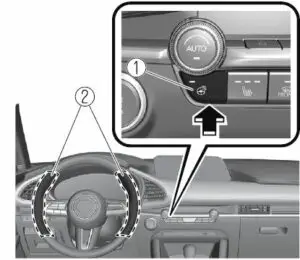
- Heated steering wheel switch
- Heating area
Manual mode
The heated steering wheel operates for about 30 minutes when the heated steering wheel switch is pressed, and then automatically turns off. To turn the heated steering wheel off manually, press the switch again.
Auto mode
The heated steering wheel can be operated in auto mode using the following procedure.
- If “Occupant Comfort” has been disabled, enable it using the following procedure.
- Select “Settings” from the Mazda Connect home screen.
- Select “Vehicle Settings”.
- Enable “Occupant Comfort”.
- Press the AUTO switch.
While in auto mode, the heated steering wheel automatically operates/turns off according to the conditions in the cabin.
NOTE
- If the heated steering wheel switch is pressed during auto mode, the heated steering wheel switches to manual mode. To return to auto mode, press the AUTO switch.
- If the ignition is switched OFF while the heated steering wheel is operating in auto mode, the heated steering wheel operates in auto mode again the next time the ignition is switched ON.
CAUTION
The following types of persons should be careful not to touch the steering wheel. Otherwise, it could cause a low-temperature burn.
- Infants, small children, elderly people, and physically challenged people
- People with delicate skin
- People who are excessively fatigued
- People who are intoxicated
- People who have taken sleep-inducing medicine such as sleeping pills or cold medicine.
Seat Belt Precautions
Seat belts help to decrease the possibility of severe injury during accidents and sudden stops. Mazda recommends that the driver and all passengers always wear seat belts.
(Mexico)
All the seats have lap/shoulder belts. These belts have retractors with inertia locks that keep them out of the way when not in use. The locks allow the belts to remain comfortable on users, but they will lock in position during a collision.
(Except Mexico)
All of the seat belt retractors are designed to keep the lap/shoulder belts out of the way when not in use. The driver’s seat belt has no provisions for child-restraint systems and has only an emergency locking mode. The driver may wear it comfortably, and it will lock during a collision. However, the front passenger’s seat and all rear lap/shoulder belt retractors operate in two modes: emergency locking mode, and for child-restraint systems, automatic locking mode. While we recommend you put all children in the rear seats, if you must use the front passenger seat for a child, slide the front passenger seat as far back as possible and make sure any child-restraint system is secured properly.
WARNING
Always wear your seat belt and make sure all occupants are properly restrained:
Not wearing a seat belt is extremely dangerous. During a collision, occupants not wearing seat belts could hit someone or things inside the vehicle or even be thrown out of the vehicle. They could be seriously injured or even killed. In the same collision, occupants wearing seat belts would be much safer. Do not wear twisted seat belts: Twisted seat belts are dangerous. In a collision, the full width of the belt is not available to absorb the impact. This puts more force on the bones beneath the belt, which could cause serious injury or death. So, if your seat belt is twisted, you must straighten the seat belt to remove any twists and to allow the full width of the belt to be used.
Never use one seat belt on more than one person at a time:
Using one seat belt for more than one person at a time is dangerous. A seat belt used in this way cannot spread the impact forces properly and the two passengers could be crushed together and seriously injured or even killed. Never use one belt for more than one person at a time and always operate the vehicle with each occupant properly restrained.
Do not operate a vehicle with a damaged seat belt:
Using a damaged seat belt is dangerous. An accident could damage the belt webbing of the seat belt in use. A damaged seat belt cannot provide adequate protection in a collision. Have an Authorized Mazda Dealer inspect all seat belt systems in use during an accident before they are used again.
Have your seat belts changed immediately if the pretensioner or load limiter has been expended:
Always have an Authorized Mazda Dealer immediately inspect the seat belt pretensioners and air bags after any collision. Like the air bags, the seat belt pretensioners and load limiters will only function once and must be replaced after any collision that caused them to deploy. A seat belt with an expended pretensioner or load limiter is still better than wearing no seat belt at all; however, if the seat belt pretensioners and load limiters are not replaced, the risk of injury in a collision will increase.
Positioning the Shoulder Portion of the Seat Belt:
Improper positioning of the shoulder portion of the seat belt is dangerous. Always make sure the shoulder portion of the seat belt is positioned across your shoulder and near your neck, but never under your arm, on your neck, or on your upper arm.
Positioning the Lap Portion of the Seat Belt:
The lap portion of the seat belt worn too high is dangerous. In a collision, this would concentrate the impact force directly on the abdominal area, causing serious injury. Wear the lap portion of the belt snugly and as low as possible.
CAUTION
Belt retraction may become difficult if the belts and rings are soiled, so try to keep them clean. For more details about cleaning the seat belts, refer to “Seat Belt Maintenance”.
- Ring
Pregnant Women and Persons with Serious Medical Conditions
Pregnant women should always wear seat belts. Ask your doctor for specific recommendations. The lap belt should be worn SNUGLY AND AS LOW AS POSSIBLE OVER THE HIPS.
The shoulder belt should be worn across your shoulder properly, but never across the stomach area. Persons with serious medical conditions also should wear seat belts. Check with your doctor for any special instructions regarding specific medical conditions.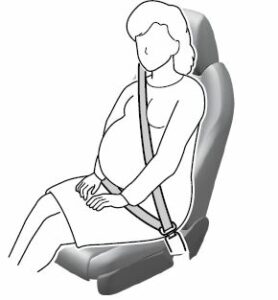
Emergency Locking Mode
When the seat belt is fastened, it will always be in the emergency locking mode. In the emergency locking mode, the belt remains comfortable on the occupant and the retractor will lock in position during a collision. If the belt is locked and cannot be pulled out, retract the belt once, and then try pulling it out slowly. If this fails, pull the belt strongly 1 time and loosen, then pull it out again slowly.(Seat Belt with Automatic Locking Mode) When the seat belt is fastened, it will always be in the emergency locking mode until it is switched to automatic locking mode by pulling it all the way out to its full length. If the belt feels tight and hinders comfortable movement while the vehicle is stopped or in motion, it may be in the automatic locking mode because the belt has been pulled too far out. To return the belt to the more comfortable emergency locking mode, wait until the vehicle has stopped in a safe, level area, retract the belt fully to convert it back to emergency locking mode and then extend it around you again.
Automatic Locking Mode (Except Mexico)
Always use the automatic locking mode to keep the child-restraint system from shifting to an unsafe position in the event of an accident. To enable seat belt automatic locking mode, pull it all the way out and connect it as instructed on the child-restraint system. It will retract down to the child-restraint system and stay locked on it. See the section on child restraint.
Seat Belt Precautions
Seat belts help to decrease the possibility of severe injury during accidents and sudden stops. Mazda recommends that the driver and all passengers always wear seat belts.
(Mexico)
All the seats have lap/shoulder belts. These belts have retractors with inertia locks that keep them out of the way when not in use. The locks allow the belts to remain comfortable on users, but they will lock in position during a collision.
(Except Mexico)
All of the seat belt retractors are designed to keep the lap/shoulder belts out of the way when not in use. The driver’s seat belt has no provisions for child-restraint systems and has only an emergency locking mode. The driver may wear it comfortably, and it will lock during a collision. However, the front passenger’s seat and all rear lap/shoulder belt retractors operate in two modes: emergency locking mode, and for child-restraint systems, automatic locking mode. While we recommend you put all children in the rear seats, if you must use the front passenger seat for a child, slide the front passenger seat as far back as possible and make sure any child-restraint system is secured properly.
Always wear your seat belt and make sure all occupants are properly restrained:
Not wearing a seat belt is extremely dangerous. During a collision, occupants not wearing seat belts could hit someone or things inside the vehicle or even be thrown out of the vehicle. They could be seriously injured or even killed. In the same collision, occupants wearing seat belts would be much safer.
Do not wear twisted seat belts: Twisted seat belts are dangerous. In a collision, the full width of the belt is not available to absorb the impact. This puts more force on the bones beneath the belt, which could cause serious injury or death. So, if your seat belt is twisted, you must straighten the seat belt to remove any twists and to allow the full width of the belt to be used.
Never use one seat belt on more than one person at a time:
Using one seat belt for more than one person at a time is dangerous. A seat belt used in this way cannot spread the impact forces properly and the two passengers could be crushed together and seriously injured or even killed. Never use one belt for more than one person at a time and always operate the vehicle with each occupant properly restrained.
Do not operate a vehicle with a damaged seat belt:
Using a damaged seat belt is dangerous. An accident could damage the belt webbing of the seat belt in use. A damaged seat belt cannot provide adequate protection in a collision. Have an Authorized Mazda Dealer inspect all seat belt systems in use during an accident before they are used again. Have your seat belts changed immediately if the pretensioner or load limiter has been expended: Always have an Authorized Mazda Dealer immediately inspect the seat belt pretensioners and air bags after any collision. Like the air bags, the seat belt pretensioners and load limiters will only function once and must be replaced after any collision that caused them to deploy. A seat belt with an expended pretensioner or load limiter is still better than wearing no seat belt at all; however, if the seat belt pretensioners and load limiters are not replaced, the risk of injury in a collision will increase.
Positioning the Shoulder Portion of the Seat Belt:
Improper positioning of the shoulder portion of the seat belt is dangerous. Always make sure the shoulder portion of the seat belt is positioned across your shoulder and near your neck, but never under your arm, on your neck, or on your upper arm.
Positioning the Lap Portion of the Seat Belt:
The lap portion of the seat belt worn too high is dangerous. In a collision, this would concentrate the impact force directly on the abdominal area, causing serious injury. Wear the lap portion of the belt snugly and as low as possible.
CAUTION
Belt retraction may become difficult if the belts and rings are soiled, so try to keep them clean. For more details about cleaning the seat belts, refer to “Seat Belt Maintenance”.
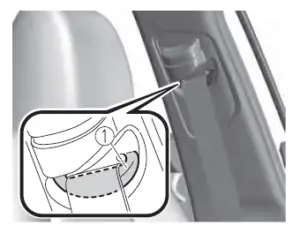
- Ring
Pregnant Women and Persons with Serious Medical Conditions
Pregnant women should always wear seat belts. Ask your doctor for specific recommendations. The lap belt should be worn SNUGLY AND AS LOW AS POSSIBLE OVER THE HIPS. The shoulder belt should be worn across your shoulder properly, but never across the stomach area. Persons with serious medical conditions also should wear seat belts. Check with your doctor for any special instructions regarding specific medical conditions.

Emergency Locking Mode
When the seat belt is fastened, it will always be in the emergency locking mode. In the emergency locking mode, the belt remains comfortable on the occupant and the retractor will lock in position during a collision. If the belt is locked and cannot be pulled out, retract the belt once, and then try pulling it out slowly. If this fails, pull the belt strongly 1 time and loosen, then pull it out again slowly.
(Seat Belt with Automatic Locking Mode)
When the seat belt is fastened, it will always be in the emergency locking mode until it is switched to automatic locking mode by pulling it all the way out to its full length. If the belt feels tight and hinders comfortable movement while the vehicle is stopped or in motion, it may be in the automatic locking mode because the belt has been pulled too far out. To return the belt to the more comfortable emergency locking mode, wait until the vehicle has stopped in a safe, level area, retract the belt fully to convert it back to emergency locking mode and then extend it around you again.
Automatic Locking Mode (Except Mexico)
Always use the automatic locking mode to keep the child-restraint system from shifting to an unsafe position in the event of an accident. To enable seat belt automatic locking mode, pull it all the way out and connect it as instructed on the child-restraint system. It will retract down to the child-restraint system and stay locked on it. See the section on child restraint.
Seat Belt
Fastening the Seat Belt
Insert the seat belt tongue into the buckle.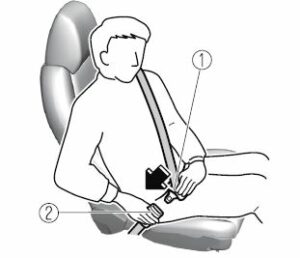
- Seat belt tongue
- Seat belt buckle
Position the lap belt as low as possible, not on the abdominal area, then adjust the shoulder belt so that it fits snugly against your body.
- Keep low on hip bone
- Take up slack
- Too high
Before fastening the rear seat belt, make sure that the seat belt passes through the seat belt guide correctly and it is not twisted.
Unfastening the Seat Belt
Depress the button on the seat belt buckle. If the belt does not fully retract, pull it out and check for kinks or twists. Then make sure it remains untwisted as it retracts.
- Button
NOTE
If a belt does not fully retract, inspect it for kinks and twists. If it is still not retracting properly, have it inspected at an Authorized Mazda Dealer.
Front Shoulder Belt Adjuster
The front seat belts have a front shoulder belt adjuster. If the seat belt contacts your neck or it slips off the shoulder, adjust the seat belt height.
To raise
To heighten the seat belt, move the front shoulder belt adjuster upward.
 To lower
To lower
To lower the seat belt, hold the front shoulder belt adjuster and lower the seat belt with the knob of the front shoulder belt adjuster pressed.
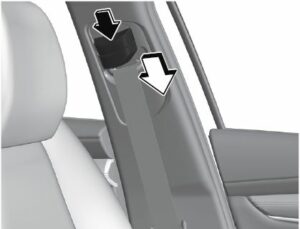 After adjusting, press the front shoulder belt adjuster downward and make sure that it is securely locked.
After adjusting, press the front shoulder belt adjuster downward and make sure that it is securely locked.
Seat Belt Warning Systems
Seat Belt Warning Systems
If it detects that the occupant seat belt is unfastened, the warning light or beep alerts the occupant.
- Refer to Seat Belt Warning Indication/Warning Light (Front seat).
- Refer to Seat Belt Warning Light (Rear seat) (Red).
- Refer to Seat Belt Warning Beep.
- Seat belt indicator light (rear seat) (green)
Rear
 The light turns on when the rear seat belt is fastened while the ignition is switched ON, and it turns off after a certain period.
The light turns on when the rear seat belt is fastened while the ignition is switched ON, and it turns off after a certain period.
Seat Belt Pretensioner and Load Limiting Systems
Seat Belt Pretensioner and Load Limiting Systems
For optimum protection, the front seat belts and rear outboard seat belts* are equipped with pretensioner and load limiting systems. For both these systems to work properly you must wear the seat belt properly.
Pretensioners:
When a collision is detected, the pretensioners deploy simultaneously with the air bags. For vehicles with the front passenger occupant classification system, the pretensioners deploy simultaneously with the air bags when a roll-over is also detected. For deployment details, refer to the SRS Air Bag Deployment Criteria . The seat belt retractors remove slack quickly as the air bags are expanding. Any time the air bags and seat belt pretensioners have fired they must be replaced. A system malfunction or operation conditions are indicated by a warning. Refer to Air Bag/Seat Belt Pretensioner System Warning Indication/Warning Light.
(With Front Passenger Occupant Classification System)
In addition, the pretensioner system for the front passenger, like the front and side passenger air bag, is designed to only deploy in accordance with the total seated weight on the front passenger seat. For details, refer to the front passenger seat weight sensors.
Load limiter:
The load limiting system releases belt webbing in a controlled manner to reduce belt force on the occupant’s chest. While the most severe load on a seat belt occurs in frontal collisions, the load limiter has an automatic mechanical function and can activate in any accident mode with sufficient occupant movement. Even if the pretensioners have not fired, the load limiting function must be checked by an Authorized Mazda Dealer.
WARNING
Wear seat belts only as recommended in this owner’s manual:
Incorrect positioning of the seat belts is dangerous. Without proper positioning, the pretensioner and load limiting systems cannot provide adequate protection in an accident and this could result in serious injury. For more details about wearing seat belts, refer to “Fastening the Seat Belt”.
Have your seat belts changed immediately if the pretensioner or load limiter has been expended: Always have an Authorized Mazda Dealer immediately inspect the seat belt pretensioners and air bags after any collision. Like the air bags, the seat belt pretensioners and load limiters will only function once and must be replaced after any collision that caused them to deploy. A seat belt with an expended pretensioner or load limiter is still better than wearing no seat belt at all; however, if the seat belt pretensioners and load limiters are not replaced, the risk of injury in a collision will increase. Do not modify the components or wiring, or use electronic testing devices on the pretensioner system: Modifying the components or wiring of the pretensioner system, including the use of electronic testing devices is dangerous. You could accidentally activate it or make it inoperable which would prevent it from activating in an accident. The occupants or repairers could be seriously injured.
Properly dispose of the pretensioner system:
Improper disposal of the pretensioner system or a vehicle with non-deactivated pretensioners is dangerous. Unless all safety procedures are followed, injury could result. Have an Authorized Mazda Dealer safely dispose of the pretensioner system or scrap a pretensioner system equipped vehicle.
- The pretensioner system may not operate depending on the type of the collision. For details, refer to the SRS Air Bag Deployment Criteria
- Some smoke (non-toxic gas) will be released when the air bags and pretensioners deploy. This does not indicate a fire. This gas normally has no effect on occupants, however, those with sensitive skin may experience light skin irritation. If residue from the deployment of the air bags or the pretensioner system gets on the skin or in the eyes, wash it off as soon as possible.
Seat Belt Extender
Seat Belt Extender
If your seat belt is not long enough, even when fully extended, a seat belt extender may be available to you at no charge from your Authorized Mazda Dealer. This extender will be only for you and for the particular vehicle and seat. Even if it plugs into other seat belts, it may not hold in the critical moment of a crash. When ordering an extender, only order one that provides the necessary additional length to fasten the seat belt properly. Please contact your Authorized Mazda Dealer for more information.
WARNING
Do not use a seat belt extender unless it is necessary:
Using a seat belt extender when not necessary is dangerous. The seat belt will be too long and not fit properly. In an accident, the seat belt will not provide adequate protection and you could be seriously injured. Only use the extender when it is required to fasten the seat belt properly.
Do not use an improper extender: Using a seat belt extender that is for another person or a different vehicle or seat is dangerous. The seat belt will not provide adequate protection and the user could be seriously injured in an accident. Only use the extender provided for you and for the particular vehicle and seat. NEVER use the extender in a different vehicle or seat. If you sell your Mazda, do not leave your seat belt extender in the vehicle. It could be used accidentally by the new owner of the vehicle. After removing the seat belt extender, discard it. Never use the seat belt extender in any other vehicle you may own in the future.
Do not use an extender that is too long:
Using an extender that is too long is dangerous. The seat belt will not fit properly. In an accident, the seat belt will not provide adequate protection and you could be seriously injured. Do not use the extender or choose one shorter in length if the distance between the extender’s buckle and the center of the user’s body is less than 15 cm (6 in).
Do not use an improper extender:
Using a seat belt extender that is for another person or a different vehicle or seat is dangerous. The seat belt will not provide adequate protection and the user could be seriously injured in an accident. Only use the extender provided for you and for the particular vehicle and seat. NEVER use the extender in a different vehicle or seat. If you sell your Mazda, do not leave your seat belt extender in the vehicle. It could be used accidentally by the new owner of the vehicle. After removing the seat belt extender, discard it. Never use the seat belt extender in any other vehicle you may own in the future.
Do not use an extender that is too long:
Using an extender that is too long is dangerous. The seat belt will not fit properly. In an accident, the seat belt will not provide adequate protection and you could be seriously injured. Do not use the extender or choose one shorter in length if the distance between the extender’s buckle and the center of the user’s body is less than 15 cm (6 in).
Do not leave a seat belt extender connected to the buckle:
Leaving a seat belt extender connected to the buckle without using the seat belt is dangerous. When the seat belt extender is connected to the driver’s seat belt buckle (or front passenger’s seat belt buckle), the SRS driver’s (or front passenger’s) air bag system will determine that the driver (or front passenger) is wearing the seat belt even if the driver (or front passenger) is not wearing it. This condition could cause the driver’s (or front passenger’s) air bag to not activate correctly and result in death or serious injury in the event of collision. Always wear the seat belt with the seat belt extender.
Do not use the seat belt extender when installing a child-restraint system on the front or rear passenger seat:
Using a seat belt extender to fasten a child-restraint system on any seat is dangerous. Always follow the
child-restraint system manufacturer’s installation instructions and never use a seat belt extender.
NOTE
When not in use, remove the seat belt extender and store it in the vehicle. If the seat belt extender is left connected, the seat belt extender might get damaged as it will not retract with the rest of the seat belt and can easily fall out of the door when not in use and be damaged. In addition, the seat belt warning light will not illuminate and function properly.
Child Restraint
Child-Restraint Precautions
Mazda strongly urges the use of child-restraint systems for children small enough to use them. You are required by law to use a child-restraint system for children in the U.S. and Canada. Check your local and state or provincial laws for specific requirements regarding the safety of children riding in your vehicle. Whatever child-restraint system you consider, please pick the appropriate one for the age and size of the child, obey the law and follow the instructions that come with the individual child-restraint system.
A child who has outgrown child-restraint systems should sit in the rear and use seat belts, both lap and shoulder. If the shoulder belt crosses the neck or face, move the child closer to the center of the vehicle in the outboard seats, and towards the buckle on the right if the child is seated on the center seat. Statistics confirm that the rear seat is the best place for all children up to 12 years of age, and more so with a supplemental restraint system (air bags). A rear-facing child-restraint system should NEVER be used on the front seat with the air bag system activated. The front passenger’s seat is also the least preferred seat for other child-restraint systems.
(With Front Passenger Occupant Classification System)
To reduce the chance of injuries caused by deployment of the front passenger air bag, the front passenger seat weight sensors occupant classification sensor works as a part of the supplemental restraint system. This system deactivates the front passenger front and side air bags and knee air bags, and also the front passenger seat belt pretensioner system when the front passenger air bag deactivation indicator light illuminates. When an infant or small child sits on the front passenger seat, the system shuts off the front passenger front and side air bags and knee air bags, and seat belt pretensioner system, so make sure the front passenger air bag deactivation indicator light illuminates. Even if the front passenger air bag is shut off, Mazda strongly recommends that children be properly restrained and child-restraint systems of all kinds are properly secured on the rear seats which are the best place for children. For more details, refer to “Front passenger seat weight sensors”.
WARNING
Use the correct size child-restraint system:
For effective protection in vehicle accidents and sudden stops, a child must be properly restrained using a seat belt or child-restraint system depending on age and size. If not, the child could be seriously injured or even killed in an accident. Follow the manufacturer’s instructions and always keep the child-restraint system buckled down: An unsecured child-restraint system is dangerous. In a sudden stop or a collision it could move causing serious injury or death to the child or other occupants. Make sure any child-restraint system is properly secured in place according to the child-restraint system manufacturer’s instructions. When not in use, remove it from the vehicle or fasten it with a seat belt, or attach it to BOTH ISOFIX/LATCH*1 lower anchors for ISOFIX/LATCH*1 child-restraint systems and the corresponding tether anchor.
ISOFIX (Mexico)/LATCH (Except Mexico)
Always secure a child in a proper child-restraint system:
Holding a child in your arms while the vehicle is moving is extremely dangerous. No matter how strong the person may be, he or she cannot hold onto a child in a sudden stop or collision and it could result in serious injury or death to the child or other occupants. Even in a moderate accident, the child may be exposed to air bag forces that could result in serious injury or death to the child, or the child may be slammed into an adult, causing injury to both child and adult.
Never use a rear-facing child-restraint system in the front seat with an air bag that could deploy:
Rear-facing child-restraint systems on the front seat are particularly dangerous even though you may feel assured that a front passenger air bag will not deploy based on the fact that the front passenger air bag deactivation indicator light illuminates. The child-restraint system can be hit by a deploying air bag and moved violently backward resulting in serious injury or death to the child.
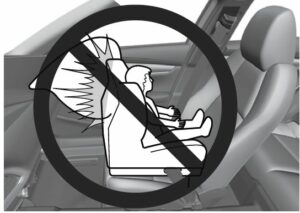 (Mexico)
(Mexico)
NEVER use a rearward facing child restraint on a seat protected by an ACTIVE AIRBAG in front of it, DEATH or SERIOUS INJURY to the CHILD can occur. Vehicles with a front passenger air bag have the following warning label. The warning label reminds you not to put a rear-facing child-restraint system on the front passenger seat at any time.
 (Except Mexico)
(Except Mexico)
Vehicles with a front passenger air bag have the following warning label. The warning label reminds you not to put a rear-facing child-restraint system on the front passenger seat at any time.
Do not install a front-facing
child-restraint system on the front passenger seat unless it is unavoidable: In a collision, the force of a deploying air bag could cause serious injury or death to the child. If installing a front-facing child-restraint system on the front passenger seat is unavoidable, move the front passenger seat as far back as possible.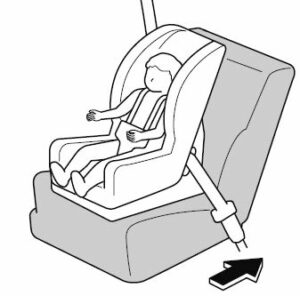 Setting a child in a child-restraint system on the front passenger seat is dangerous under certain conditions
Setting a child in a child-restraint system on the front passenger seat is dangerous under certain conditions
(With Front Passenger Occupant Classification System):
Your vehicle is equipped with front passenger seat weight sensors. Even with the front passenger seat weight sensors, if you must use the front passenger seat to seat a child, using a child-restraint system on the front passenger seat under the following conditions increases the danger of the front passenger air bag deploying and could result in serious injury or death to the child.
- The front passenger air bag deactivation indicator light does not illuminate when seating a child in the child-restraint system.
- Luggage or other items are placed on the seat with the child in the child-restraint system.
- A rear passenger or luggage pushing or pulling down on the front passenger seatback.
- Luggage or other items are placed on the seatback or hung on the head restraint.
- The seat is washed.
- Liquids are spilled on the seat.
- The front passenger seat is moved backward, pushing into luggage or other items placed behind it.
- The front passenger seatback contacts the rear seat.
- Luggage or other items are placed between the front passenger seat and driver seat.
- An electric device is put on the front passenger’s seat.
- An additional electrical device, such as a seat warmer is installed to the surface of the front passenger seat.
- Any accessories, which might increase the total seated weight on the front passenger seat, are attached to the front passenger seat.
The designated positions with seat belts on the rear seats are the safest places for children. Always use seat belts and child restraints.
Do not allow a child or anyone to lean over to or against the side window of a vehicle with side and curtain air bags:
It is dangerous to allow anyone to lean over to or against the side window, the area of the front passenger seat, the front and rear window pillars and the roof edge along both sides from which the side and curtain air bags deploy, even if a child-restraint system is used. The impact of inflation from a side or curtain air bag could cause serious injury or death to an out of position child. Furthermore, leaning over to or against the door could block the side and curtain air bags and eliminate the advantages of supplemental protection. Because the front seats are equipped with front air bags, the rear seat is always a better location for children. Take special care not to allow a child to lean over to or against the side window, even if the child is seated in a child-restraint system.
Never use one seat belt on more than one person at a time:
Using one seat belt for more than one person at a time is dangerous. A seat belt used in this way cannot spread the impact forces properly and the two passengers could be crushed together and seriously injured or even killed. Never use one belt for more than one person at a time and always operate the vehicle with each occupant properly restrained.
CAUTION
A seat belt or child-restraint system can become very hot in a closed vehicle during warm weather. To avoid burning yourself or a child, check them before you or your child touches them.
NOTE
Your Mazda is equipped with ISOFIX/LATCH*1 lower anchors for attachment of specially designed ISOFIX/LATCH*1 child-restraint systems on the rear seats. When using these anchors to secure a child-restraint system, refer to “Using ISOFIX Lower Anchor (Mexico)/Using LATCH Lower Anchor (Except Mexico)” . ISOFIX (Mexico)/LATCH (Except
Child-Restraint System Installation
Categories of Child-Restraint Systems NOTE When purchasing, ask the manufacturer of the child-restraint system which type of child-restraint system is appropriate for your child and vehicle.
(Mexico)
Child-restraint systems are classified into the following 5 groups according to the UN-R 44 and UN-R 129 regulation.
| Group | Age | Weight | Size Classification/ Fixture (CRF) |
| 0 | Up to about 9 months old | Up to 10 kg (up to 22 lb) | ISO/L1 |
| ISO/L2 | |||
| ISO/R1 | |||
| 0+ | Up to about 2 years old | Up to 13 kg (up to 29 lb) | ISO/R1 |
| ISO/R2 | |||
| ISO/R3 | |||
| 1 | About 8 months to 4 years old | 9 kg ― 18 kg (20 lb ― 40 lb) | ISO/R2 |
| ISO/R3 | |||
| ISO/F2 | |||
| ISO/F2X | |||
| ISO/F3 | |||
| 2 | About 3 to 7 years old | 15 kg ― 25 kg (33 lb ― 55 lb) | ― |
| 3 | About 6 to 12 years old | 22 kg ― 36 kg (48 lb ― 79 lb) | ― |
(Except Mexico) Please comply with the legal regulations concerning the use of child-restraint systems in your country.
Child-Restraint System Types
In this owner’s manual, explanation of child-restraint systems is provided for the following three types of popular child-restraint systems: infant seat, child seat, booster seat.
NOTE
- Installation position is determined by the type of child-restraint system. Always read the manufacturer’s instructions and this owner’s manual carefully.
- Due to variations in the design of child-restraint systems, vehicle seats and seat belts, all child-restraint systems may not fit all seating positions. Before purchasing a child-restraint system, it should be tested in the specific vehicle seating position (or positions) where it is intended to be used. If a previously purchased child-restraint system does not fit, you may need to purchase a different one that will.
Infant seat
An infant seat provides restraint by bracing the infant’s head, neck and back against the seating surface. Equal to Group 0 and 0+ of the UN-R 44 and UN-R 129 regulation.
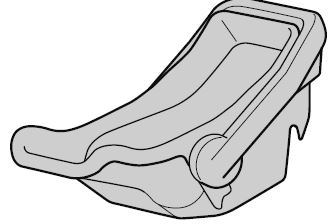 Child seat
Child seat
A child seat restrains a child’s body using the harness. Equal to Group 1 of the UN-R 44 and UN-R 129 regulations.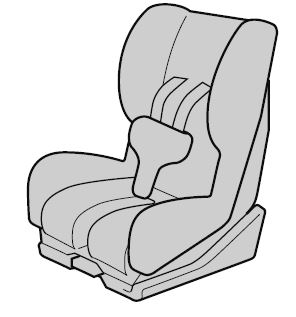 Booster seat
Booster seat
A booster seat is a child restraint accessory designed to improve the fit of the seat belt system around the child’s body. Equal to Group 2 and 3 of the UN-R 44 and UN-R 129 regulation.
- Full booster seat
- Backless booster seat
When using a backless booster seat, always install the vehicle head restraint to the seat where the backless booster seat is installed.
Child-Restraint System Suitability for Various Seat Positions Table
Child-Restraint System Suitability for Various Seat Positions Table
(Mexico)
Provided information in the table shows your child-restraint system suitability for various seating position. For installation suitability of other manufacturer child-restraint system, carefully consult the manufacturer’s instructions which accompany the child-restraint system. When installing a child-restraint system, the following points must be observed:
- Always remove the head restraint before installing a child-restraint system. However, when installing a backless booster seat, always install the vehicle head restraint to the seat where the backless booster seat is installed. In addition, always use a tether strap and attach it securely.
- When installing a child-restraint system to the front passenger seat, adjust the seat slide position as far back as possible.
- When it is difficult to install a child-restraint system to the front passenger seat, or the seat belt cannot be secured to the child-restraint system, perform the following operations to adjust the seat holding the child-restraint system so that the seat belt can be secured completely to it.
- Move the seat forward or back.
- Move the seatback forward or back.
- Move the seat upward or downward.
- (Vehicles with height adjustment function)
- When installing a child-restraint system to the rear seat, adjust the front seat position so that the front seat does not contact the child-restraint system.
- When installing a child-restraint system equipped with a tether, remove the head restraint.
- An i-Size child-restraint system refers to a child-restraint system which has acquired i-Size category certification for the UN-R 129 regulation.
- When installing a child-restraint system to the rear seat,
| Seating position | Passenger | Rear (Left) | Rear (Center) | Rear (Right) |
| Seating position suitable for universal belted (Yes/No) | Yes (UF) | Yes (U) | Yes (U) | Yes (U) |
| Size seating position (Yes/No) | No | No | No | No |
| Largest suitable rearward facing fixture (R1) | No | Yes (IL) | No | Yes (IL) |
| Largest suitable rearward facing fixture (R2) | No | Yes (IL) | No | Yes (IL) |
| Largest suitable rearward facing fixture (R2X) | No | Yes (IL) | No | Yes (IL) |
| Largest suitable rearward facing fixture (R3) | No | Yes (IL) | No | Yes (IL) |
| Largest suitable for- ward facing fixture (F2) | No | Yes (IUF) | No | Yes (IUF) |
| Largest suitable for- ward facing fixture (F2X) | No | Yes (IUF) | No | Yes (IUF) |
| Largest suitable for- ward facing fixture (F3) | No | Yes (IUF) | No | Yes (IUF) |
| Largest suitable lateral facing fixture (L1) | No | No | No | No |
| Largest suitable lateral facing fixture (L2) | No | No | No | No |
| Largest suitable booster fixture (B2) | No | Yes (IUF) | No | Yes (IUF) |
| Largest suitable booster fixture (B3) | No | Yes (IUF) | No | Yes (IUF) |
| Seating position | Passenger | Rear (Left) | Rear (Center) | Rear (Right) |
| Non i-size compatible with a support leg (Yes/No | Yes*1 | Yes | No | Yes |
| Lower ISOFIX an- chorages but with- out Top Tether (Yes/No) | No | No | No | No |
U = Suitable for “universal” category restraints approved for use in this mass group. UF = Suitable for forward-facing “universal” category restraints approved for use in this mass group. IUF = Suitable for ISOFIX forward child restraints systems of universal category approved for use in the mass group. L = Suitable for particular child restraints given on attached list. These restraints may be of the “specific vehicle”, “restricted” or “semi-universal” categories. IL = Suitable for particular ISOFIX child restraint systems (CRS) given in the attached list. These ISOFIX CRS are those of the “specific vehicle”, “restricted” or “semi-universal” categories. i-U = Suitable for i-Size “universal” Child Restraint Systems forward and rearward facing. i-UF = Suitable for forward-facing i-Size “universal” Child Restraint Systems only. Yes = Child-restraint system can be secured on the seat. No = Child-restraint system cannot be secured on the seat, or there is no fixture. X = Child-restraint system cannot be installed. *1 Child restraint system can only be installed in the forward-facing position. A Mazda genuine child-restraint system can be installed. Regarding child-restraint systems which can be installed, refer to the accessories catalog.
(Except Mexico)
- Regarding child-restraint systems which can be installed to your Mazda, consult an Authorized Mazda Dealer.
- A child-restraint system with a support leg cannot be installed on the rear center seat position.
- Please comply with the legal regulations concerning the use of child-restraint systems in your country.
- For the CRS which do not carry the ISO/XX size class identification (A to G), for the applicable mass group, the child seat manufacturer shall indicate the vehicle specific LATCH child-restraint systems recommended for each position.
Installing Child-Restraint Systems
Installing Child-Restraint Systems
Accident statistics reveal that a child is safer in the rear seat. The front passenger’s seat is clearly the worst choice for any child under 12, and with rear-facing child-restraint systems it is clearly unsafe due to air bags.
NOTE
Even if your vehicle is equipped with front passenger occupant classification sensor (page 2-70), which automatically deactivates the front passenger air bag, a rear seat is the safest place for a child of any age or size. Some child-restraint systems now come with tethers and therefore must be installed on the seats that take tethers to be effective. In your Mazda, tethered child-restraint systems can only be accommodated in the three positions on the rear seat. Some child-restraint systems also employ specially designed ISOFIX/LATCH*1 attachments; refer to “Using ISOFIX Lower Anchor (Mexico)/Using LATCH Lower Anchor (Except Mexico)” .
ISOFIX (Mexico)/LATCH (Except Mexico)
WARNING
Tethered Child-Restraint Systems Work Only on Tether-Equipped Rear Seats:
Installation of a tether equipped child-restraint system in the front passenger’s seat defeats the safety design of the system and will result in an increased chance of serious injury if the child-restraint system goes forward without benefit of being tethered. Place tether equipped child-restraint systems where there are tether anchors.
Anchor Bracket Anchor brackets for securing
child-restraint systems are equipped in the vehicle. Locate each anchor position using the illustration. To install a child-restraint system, remove the head restraint. Always follow the instruction manual accompanying the child-restraint system.
Anchor bracket location
Use the indicated anchor bracket locations when installing a child-restraint system equipped with a tether.
- For right
- For center (Except Mexico)
- For left
- 4 Anchor bracket
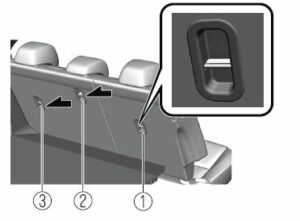
- For right
- For center (Except Mexico)
- For left
WARNING Always attach the tether strap to the correct tether anchor position:
Attaching the tether strap to the incorrect tether anchor position is dangerous. In a collision, the tether strap could come off and loosen the child-restraint system. If the child-restraint system moves it could result in death or injury to the child. Always remove the head restraint and install child-restraint system: Installing a child-restraint system without removing the head restraint is dangerous. The child-restraint system cannot be installed correctly which may result in death or injury to the child in a collision.
(Mexico)
If the top tether strap does not reach the anchor bracket, purchase and use an extension strap provided by the CRS manufacturer.
(4–Door)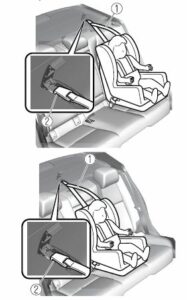
- Tether strap
- Anchor bracket

- Tether strap
- Anchor bracket
- Forward
Always install the head restraint and adjust it to the appropriate position after removing the child-restraint system:
Driving with the head restraint removed is dangerous as impact to the occupant’s head cannot be prevented during emergency braking or in a collision, which could result in a serious accident, injury or death.
Using Automatic Locking Mode (Except Mexico)
Follow these instructions when using a child-restraint system, unless you are attaching a LATCH-equipped child-restraint system to the rear LATCH lower anchors. Refer to “Using LATCH Lower Anchor”
NOTE
Follow the child-restraint system manufacturer’s instructions carefully. If you are not sure whether you have a LATCH system or tether, check in the child-restraint system manufacturer’s instructions and follow them accordingly. Depending on the type of child-restraint system, it may use LATCH system instead of seat belts or if the belt goes across the child’s chest, may recommend against using automatic locking mode.
- Make sure the seatback is securely latched by pushing it back until it is fully locked.
- Remove the head restraint. However, when installing a backless booster seat, always install the vehicle head restraint to the seat where the backless booster seat is installed. Refer to Head Restraints.
- Secure the child-restraint system with the lap portion of the lap/shoulder belt. See the manufacturer’s instructions on the child-restraint system for belt routing instructions.
- To get the retractor into the automatic locking mode, pull the shoulder belt portion of the seat belt until the entire length of the belt is out of the retractor.
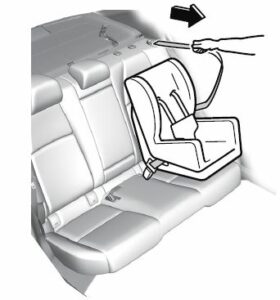
- Push the child-restraint system firmly into the vehicle seat. Be sure the belt retracts as snugly as possible. A clicking noise from the retractor will be heard during retraction if the system is in the automatic locking mode. If the belt does not lock the seat down tight, repeat this step.

NOTE
- Inspect this function before each use of the child-restraint system. You should not be able to pull the shoulder belt out of the retractor while the system is in the automatic locking mode. When you remove the child-restraint system, be sure the belt fully retracts to return the system to emergency locking mode before occupants use the seat belts.
- If your child-restraint system requires the use of a tether strap, refer to the manufacturer’s instructions to hook and tighten the tether strap.
WARNING Use the tether and tether anchor only for a child-restraint system:
Using the tether or tether anchor to secure anything but a child-restraint system is dangerous. This could weaken or damage the tether or tether anchor and result in injury.
Always remove the head restraint and install child-restraint system (except when installing a backless booster seat): Installing a child-restraint system without removing the head restraint is dangerous. The child-restraint system cannot be installed correctly which may result in death or injury to the child in a collision.
(4–Door)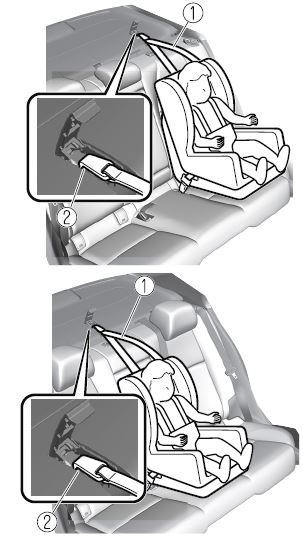
- Tether strap
- Anchor bracket
(5–Door)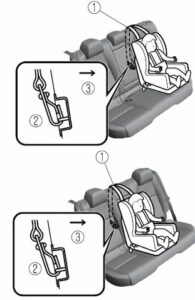
- Tether strap
- Anchor bracket
- Forward
Always attach the tether strap to the correct tether anchor position: Attaching the tether strap to the incorrect tether anchor position is dangerous. In a collision, the tether strap could come off and loosen the child-restraint system. If the child-restraint system moves it could result in death or injury to the child.
Always install the head restraint and adjust it to the appropriate position after removing the child-restraint system:
Driving with the head restraint removed is dangerous as impact to the occupant’s head cannot be prevented during emergency braking or in a collision, which could result in a serious accident, injury or death. Refer to Head Restraints.
If You Must Use the Front Seat for Children
If you cannot put all children in the rear seat, at least put the smallest children in the rear and be sure the largest child up front uses the shoulder belt over the shoulder. NEVER put a rear-facing child-restraint system on the front passenger seat whether your vehicle is equipped with an occupant classification sensor or not. This seat is also not set up for tethered child-restraint systems, put them in one of the rear seat positions set up with tether anchors.
Likewise the ISOFIX/LATCH*1
child-restraint system cannot be secured in the front passenger’s seat and should be used in the rear seat. Do not allow anyone to sleep against the side window since your vehicle has side and curtain air bags, it could cause serious injuries to an out of position occupant. As children more often sleep in cars, it is better to put them in the rear seat. If installing the child-restraint system on the front seat is unavoidable, follow these instructions when using a front-facing child-restraint system in the front passenger’s seat.
*1 ISOFIX (Mexico)/LATCH (Except Mexico)
NOTE
- To check if your front seats have side air bags: Mazda vehicles equipped with side air bag will have a “SRS AIRBAG” tag on the outboard shoulder of the front seats.
Always move the front passenger seat as far back as possible if installing a front-facing child-restraint system on it is unavoidable:
As your vehicle has front air bags and doubly so because your vehicle has side air bags, a front-facing child-restraint system should be put on the front passenger seat only when it is unavoidable. Even if the front passenger air bag deactivation indicator light illuminates, always move the seat as far back as possible, because the force of a deploying air bag could cause serious injury or death to the child.
Never use a rear-facing child-restraint system in the front seat with an air bag that could deploy:
Rear-facing child-restraint systems on the front seat are particularly dangerous. Even in a moderate collision, the child-restraint system can be hit by a deploying air bag and moved violently backward resulting in serious injury or death to the child. Even though you may feel assured that the front passenger air bag will not deploy based on the fact that the front passenger air bag deactivation indicator light illuminates, you should not use a rear-facing child-restraint system in the front seat.
Do not allow a child or anyone to lean over to or against the side window of a vehicle with side and curtain air bags:
It is dangerous to allow anyone to lean over to or against the side window, the area of the front passenger seat, the front and rear window pillars and the roof edge along both sides from which the side and curtain air bags deploy, even if a child-restraint system is used. The impact of inflation from a side or curtain air bag could cause serious injury or death to an out of position child. Furthermore, leaning over to or against the door could block the side and curtain air bags and eliminate the advantages of supplemental protection. Because the front seats are equipped with front air bags, the rear seat is always a better location for children. Take special care not to allow a child to lean over to or against the side window, even if the child is seated in a child-restraint system.
Always remove the head restraint and install child-restraint system (except when installing a backless booster seat):
Installing a child-restraint system without removing the head restraint is dangerous. The child-restraint system cannot be installed correctly which may result in death or injury to the child in a collision.
Always install the head restraint and adjust it to the appropriate position after removing the child-restraint system:
Driving with the head restraint removed is dangerous as impact to the occupant’s head cannot be prevented during emergency braking or in a collision, which could result in a serious accident, injury or death. Refer to Head Restraints.
Front Passenger’s Seat Child-Restraint System Installation (With Front Passenger Occupant Classification System)
- Make sure the ignition is switched off.
- Slide the seat as far back as possible.
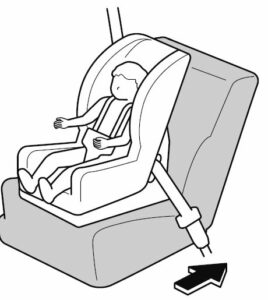
- Remove the head restraint. However, when installing a backless booster seat, always install the vehicle head restraint to the seat where the backless booster seat is installed. Place the child-restraint system on the seat without putting your weight on the seat and fasten the seat belt. See the manufacturer’s instructions on the child-restraint system for belt routing instructions.
- To get the retractor into the automatic locking mode, pull the shoulder belt portion of the seat belt until the entire length of the belt is out of the retractor.
- Push the child-restraint system firmly into the vehicle seat. Be sure the belt retracts as snugly as possible. A clicking noise from the retractor will be heard during retraction if the system is in automatic locking mode. If the belt does not lock the seat down tight, repeat the previous step and also this one.
NOTE
- Inspect this function before each use of the child-restraint system. You should not be able to pull the shoulder belt out of the retractor while the system is in the automatic locking mode. When you remove the child-restraint system, be sure the belt fully retracts to return the system to emergency locking mode before occupants use the seat belts. Follow the child-restraint system manufacturer’s instructions carefully. Depending on the type of child-restraint system, it may not employ seat belts which are in automatic locking mode. Seat your child safely in the child-restraint system and secure the child according to the instructions from the child-restraint system manufacturer. Switch the ignition ON and make sure the front passenger air bag deactivation indicator light illuminates after installing a child-restraint system on the front passenger seat. If the front passenger air bag deactivation indicator light does not illuminate, remove the child-restraint system, switch the ignition to OFF, and then re-install the child-restraint system.
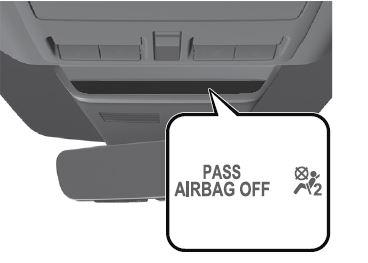 WARNING
WARNING
Do not seat a child in a child-restraint system on the front passenger seat if the front passenger air bag deactivation indicator light does not illuminate:
While it is always better to install any child-restraint system on the rear seat, it is imperative that a child-restraint system ONLY be used on the front passenger seat if the deactivation indicator light illuminates when the child is seated in the child-restraint system . Seating a child in a child-restraint system installed on the front passenger seat with the front passenger air bag deactivation indicator light not illuminated is dangerous. If this indicator light does not illuminate, this means that the front passenger front and side air bags, and knee air bags, and seat belt pretensioners are ready for deployment. If an accident were to deploy an air bag, a child in a child-restraint system sitting in the front passenger seat could be seriously injured or killed. If the indicator light does not illuminate after seating a child in a child-restraint system on the front passenger seat, seat a child in a child-restraint system on the rear seat and consult an Authorized Mazda Dealer as soon as possible.
Using ISOFIX Lower Anchor (Mexico)/Using LATCH Lower Anchor (Except Mexico)
Your Mazda is equipped with ISOFIX/LATCH*1 lower anchors for attachment of specially designed ISOFIX/LATCH*1 child-restraint systems in the rear seats. Both anchors must be used, otherwise the seat will bounce around and put the child in danger. Most ISOFIX/LATCH*1 child-restraint systems must also be used in conjunction with a tether to be effective. If they have a tether you must use it to better assure your child’s safety.
Follow the manufacturer’s instructions for the use of the child-restraint system:
An unsecured child-restraint system is dangerous. In a sudden stop or a collision it could move causing serious injury or death to the child or other occupants. Make sure the child-restraint system is properly secured in place according to the child-restraint system manufacturer’s instructions.
Never attach two child-restraint systems to the same ISOFIX/LATCH*1 lower anchor:
Attaching two child-restraint systems to the same ISOFIX/LATCH*1 lower anchor is dangerous. In a collision, one anchor may not be strong enough to hold two child-restraint system attachments, and it may break, causing serious injury or death. If you use the seat position for another child-restraint system when an outboard ISOFIX/LATCH*1 position is occupied, use the center seat belts instead, and the tether if tether-equipped.
Make sure the child-restraint system is properly secured:
An unsecured child-restraint system is dangerous. In a sudden stop or a collision it could move causing serious injury or death to the child or other occupants. Follow the child-restraint system manufacturer’s instructions on belt routing to secure the seat just as you would with a child in it so that nobody is tempted to put a child in an improperly secured seat later on. When not in use, remove it from the vehicle or fasten it with a seat belt, or attach it to BOTH ISOFIX/LATCH*1 lower anchors for ISOFIX/LATCH*1 child-restraint systems. Make sure there are no seat belts or
foreign objects near or around the ISOFIX/LATCH*1 child-restraint system:
Not following the child-restraint system manufacturer’s instructions when installing the child-restraint system is dangerous. If seat belts or a foreign object prevent the child-restraint system from being securely attached to the ISOFIX/LATCH*1 lower anchors and the child-restraint system is installed improperly, the child-restraint system could move in a sudden stop or collision causing serious injury or death to the child or other occupants. When installing the child-restraint system, make sure there are no seat belts or foreign objects near or around the ISOFIX/LATCH*1 lower anchors. Always follow the child-restraint system manufacturer’s instructions.
1 ISOFIX (Mexico)/LATCH (Except Mexico) Installation on rear outboard seats
- First, adjust the front seat to allow clearance between the child-restraint system and the front seat. Refer to Adjusting the Driver’s Seat on page 2-5. Refer to Adjusting the Front Passenger’s Seat.
- Make sure the seatback is securely latched by pushing it back until it is fully locked.
- Remove the cover of the child-restraint system’s ISOFIX/LATCH*1 lower anchors to verify the locations of the ISOFIX/LATCH*1 lower anchors.
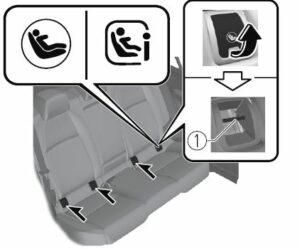 Lower anchor
Lower anchor
NOTE-
- The ISOFIX/LATCH*1 lower anchors marking on the cover indicates the position of the ISOFIX/LATCH*1 lower anchors for the attachment of a child-restraint system.
- Store the removed cover so that it does not get lost.
-
- Remove the head restraint. However, when installing a backless booster seat, always install the vehicle head restraint to the seat where the backless booster seat is installed. Refer to Head Restraints.
- Secure the child-restraint system using BOTH ISOFIX/LATCH*1 lower anchors, following the child-restraint system manufacturer’s instruction. Pull on the child-restraint to be sure both anchors are engaged.
- If your child-restraint system came equipped with a tether, that means it is very important to properly secure the tether for child safety. Please carefully follow the child-restraint system manufacturer’s instructions when installing tethers.
ISOFIX (Mexico)/LATCH (Except Mexico) WARNING Use the tether and tether anchor only for a child-restraint system:
Using the tether or tether anchor to secure anything but a child-restraint system is dangerous. This could weaken or damage the tether or tether anchor and result in injury.
Always remove the head restraint and install child-restraint system (except when installing a backless booster seat):
Installing a child-restraint system without removing the head restraint is dangerous. The child-restraint system cannot be installed correctly which may result in death or injury to the child in a collision.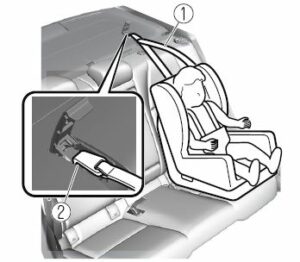
- Tether strap
- Anchor bracket
(5–Door) - Tether strap
- Anchor bracket
- Forward
- Anchor bracket
Always attach the tether strap to the correct tether anchor position: Attaching the tether strap to the incorrect tether anchor position is dangerous. In a collision, the tether strap could come off and loosen the child-restraint system. If the child-restraint system moves it could result in death or injury to the child.
Always install the head restraint and adjust it to the appropriate position after removing the child-restraint system:
Driving with the head restraint removed is dangerous as impact to the occupant’s head cannot be prevented during emergency braking or in a collision, which could result in a serious accident, injury or death. Refer to Head Restraints. Always attach the tether strap to the correct tether anchor position: Attaching the tether strap to the incorrect tether anchor position is dangerous. In a collision, the tether strap could come off and loosen the child-restraint system. If the child-restraint system moves it could result in death or injury to the child.
Always install the head restraint and adjust it to the appropriate position after removing the child-restraint system:
Driving with the head restraint removed is dangerous as impact to the occupant’s head cannot be prevented during emergency braking or in a collision, which could result in a serious accident, injury or death. Refer to Head Restraints.
Installation on rear center seat
The ISOFIX/LATCH*1 lower anchors at the center of the rear seat are much further apart than the sets of ISOFIX/LATCH*1 lower anchors for child-restraint system installation at other seating positions. Child-restraint systems with rigid ISOFIX/LATCH*1 attachments cannot be installed on the center seating position. Some ISOFIX/LATCH*1 equipped child-restraint systems can be placed in the center position and will reach the nearest ISOFIX/LATCH*1 lower anchors which are 434 mm (17.1 in) apart. ISOFIX/LATCH*1 compatible child-restraint systems (with attachments on belt webbing) can be used at this seating position only if the child-restraint system manufacturer’s instructions state that the child-restraint system can be installed to ISOFIX/LATCH*1 lower anchors that are 434 mm (17.1 in) apart. Do not attach two child-restraint systems to the same ISOFIX/LATCH*1 lower anchor. If your child-restraint system has a tether, it must also be used for your child’s optimum safety. The procedure is the same as the installation for the rear outboard seats. *1 ISOFIX (Mexico)/LATCH (Except Mexico)
ISOFIX/LATCH*1 lower anchor location WARNING
WARNING
Always remove the head restraint and install child-restraint system (except when installing a backless booster seat):
Installing a child-restraint system without removing the head restraint is dangerous. The child-restraint system cannot be installed correctly which may result in death or injury to the child in a collision.
- Tether strap
- Anchor bracket
(5–Door)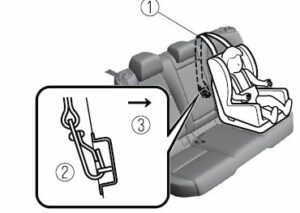
- Tether strap
- Anchor bracket
- Forward
Always attach the tether strap to the correct tether anchor position: Attaching the tether strap to the incorrect tether anchor position is dangerous. In a collision, the tether strap could come off and loosen the child-restraint system. If the child-restraint system moves it could result in death or injury to the child.
Always install the head restraint and adjust it to the appropriate position after removing the child-restraint system:
Driving with the head restraint removed is dangerous as impact to the occupant’s head cannot be prevented during emergency braking or in a collision, which could result in a serious accident, injury or death. Refer to Head Restraints.
*1ISOFIX (Mexico)/LATCH (Except Mexico)
FAQs
A tiny automobile with a typical seating capacity of five people is the 2021 Mazda3.
Depending on the model level, the 2021 Mazda3’s basic seat features may change. The majority of versions do, however, come with cloth-trimmed seats that can be adjusted manually for the driver and front passenger and with adjustable headrests.
Yes, the driver and front passenger’s seats in various 2021 Mazda3 grade levels may be heated.
Yes, some model levels of the 2021 Mazda3 often come with a center armrest with cupholders.
Yes, the 2021 Mazda3 typically has a 60/40 split-folding rear seat that can be folded flat to increase the cargo space as needed.
Yes, leather-trimmed seats may be an option on the 2021 Mazda3’s higher specification levels.
In order to fasten kid seats, the 2021 Mazda3 should have LATCH (Lower Anchors and Tethers for Children) anchors.
Depending on the person’s size and preferences, the 2021 Mazda3’s rear seats may or may not be comfortable. To gauge how comfortable the chairs are, it is advised to test them out firsthand.
The driver and front passenger seat belts on the 2021 Mazda3 are usually adjustable to provide a good fit.
Yes, it’s likely that the 2021 Mazda3 will include seat belts with load limiters to lessen the force of the belts as well as pretensioners, which tighten the belts in the event of a crash.
In order to increase safety and urge occupants to fasten their seatbelts, many contemporary automobiles, like the 2021 Mazda3, are outfitted with rear seat belt reminders.
No significant safety issues were recorded with the Mazda3’s seats or seat belts as of my most recent update in September 2021. But it’s always important to be informed about any safety alerts or recalls that Mazda or the appropriate authorities may issue.
Useful Links
View Full User: 2021 Mazda3 User Manual | Auto User Guide
Download Link: Owner’s – Manuals, Guides, Maintenance Schedules | Mazda USA

